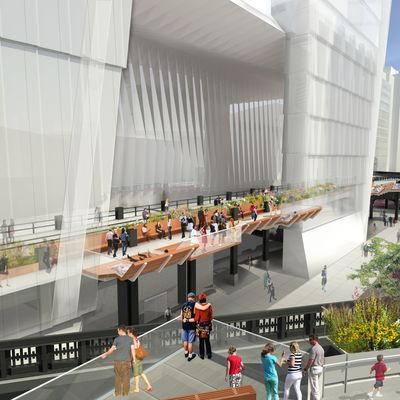
Ever since the High Line was conceived a dozen years ago, it has acted as a design laboratory, a real-estate value generator, a tourist attractor, and a metaphor for the city’s evolution from a place of weeds and rusting iron into a sanctuary of hip. The first two segments weave through old buildings and have catalyzed new ones. A new kind of urban ecology has emerged from the combination of industrial relic with new “peel-up” benches, concrete slats interlaced with grass, repurposed railroad tracks, and artfully “wild” plantings.
Now comes the final part of the trilogy, presaged by another round of renderings and another fund-raising push, and it looks like the story will get a supremely happy ending.
The once-threatened spur, sticking out over Tenth Avenue at 30th Street, may wind up as a garden or a theater, but in any case it won’t be demolished. The design has not hardened into self-parody, or been watered down, or made irrelevant. Instead, it has become more sophisticated. Benches will hang off the side of the walkway. The rail line’s structure will be bared and coated in rubber, turning massive beams into a jungle gym. The peel-up bench will mutate into desks, planters, and water fountains.
Other cities, craving the High Line’s economic engine, have drawn exactly the wrong lesson: that an obsolete elevated railroad line can be transfigured into a public park. But the original team of designers, James Corner Field Operations and Diller Scofidio + Renfro, have remained alert to the complexities of a fragile triumph. The context shifts along the park’s length, from the boutiques and restaurants (and the future Whitney Museum) clustered around Gansevoort Street, past the art galleries of West Chelsea and an evolving residential district, to a new high-density frontier. For now, the High Line ends at an urban wilderness of train tracks and open sky. In the future, that horizon will close, hemmed in by the massive skyscrapers of Hudson Yards. So the third leg is being designed to honor both the area’s industrial past and its white-collar future. The old iron-sided railroad bed will thread through the base of the Coach headquarters now being designed by Kohn Pedersen Fox and sidle alongside a planned residential tower by Diller Scofidio + Renfro. The park’s shaggy vegetation will brush against towering walls of glass.
One of the High Line’s strengths is its sponge-like sensitivity to its haphazard history. The plantings, for instance, contain a memory of the wildflowers born from seeds that hitched a ride on freight trains and dropped off at their destination. For a time, while the park waits for the build-out of Hudson Yards, a walkway will run alongside the old weedy tracks, turning the past into a temporary exhibit. It’s an expedient but inspired move, because designers and the public can both learn from such intermediate steps. One lovely touch in the design of the final section is a staircase at 30th Street and Tenth Avenue emulating the stopgap structure that currently vaults over the High Line at 20th Street and that has turned into an unexpected beauty spot. Visitors tend to pause there for an extra few feet of height and a slightly more expansive view, an unconscious habit that the designers wisely decided to enshrine because it lies at the heart of the park’s urban soul.






























